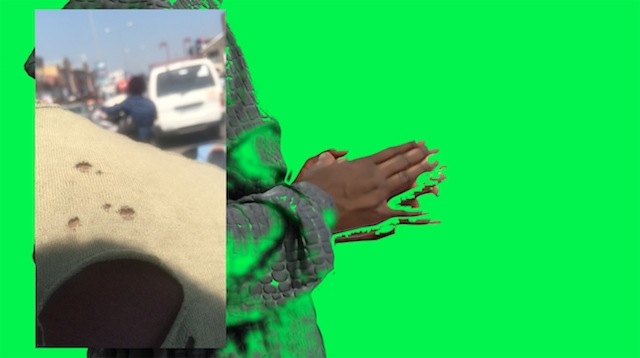In a world where social interaction is increasingly mediated by social media, Sandra Mujinga investigates the mechanisms of self-image construction on digital platforms from the viewpoint of a user-producer of her own subjectivity. Like many artists of her generation, Mujinga has grown up with the centrality of the web in daily life as an undeniable fact, but her works stand out from the ‘postinternet’ crowd as intimate existential meditations that focus on the human element of the equation. Indeed, her work is not about the web. On the contrary: hers is a very personal perspective from someone who happens to have experienced a great part of life through digital technologies, and for whom these have become second nature.
In the video installation Throwing Voice (2016), the artist’s android-like avatar, created through a live model clad in a futuristic faux-snakeskin jumpsuit, is projected against a chroma-key green background. The screen is placed behind a group of cylindrical structures in clear Perspex that refract the green light onto the walls, merging the immaterial space of the video with the physical space of the gallery. Mujinga’s figure paces back and forth, seemingly stripped of any sign of character or subjectivity. The only index of a human presence in the work is the sound of YouTube tutorials by black women giving advice on contouring (the application of makeup to highlight one’s cheekbones).
Mujinga’s work addresses how self-representation is performed in digital media – but it also points to what is lost when the subject is reduced to a constructed image
Mujinga’s work, which I first encountered at her solo exhibition Real Friends at Oslo Kunstforening last autumn, addresses how self-representation is performed in digital media, but it also points to the anxiety generated by what is lost when the subject is reduced to a completely constructed image whose fulfilment is measured by the amount of ‘likes’ it gets on any given social platform. In a recent interview, the artist spoke of a ‘fear of solipsism’ that emerges when most of our daily interactions take place online and we begin to exist in a constant feedback loop, even if our sense of isolation is mitigated through sharing our output with others.
What is interesting about her approach, however, is that it can hardly be perceived as a one-dimensional lament on the subject’s loss of complexity. Mujinga fully embraces the DIY ethos fostered by digital technologies: she shoots and edits her videos, composes the soundtracks, designs the costumes. In this sense, online tools are ambivalently positioned as both instruments for increased artistic freedom and the source of new types of neuroses that result from lack of physical interaction. As a Norwegian citizen born in the Democratic Republic of the Congo, and currently working between Malmö and Oslo, her own experience reflects the entangled system of different time zones that characterises digital life. In the video ILYNL (It’s Like You Never Left) (2016), also shown at Oslo Kunstforening, the same avatar reappears multiplied in a multiscreen surface that includes mobile phone footage taken in Africa and Europe, sometimes layered with emojis. The artist navigates these time zones simultaneously, at one point remarking on the deathly-empty streets of Malmö on a night out and the contrasting vibrancy in Rwanda at the same time, a trivial comment that highlights the unnatural condition of being split into two or more places at once. At times visually engaging and distressing, but also silly and funny, Mujinga’s works are ongoing experiments in how to exist as a subject in a hyper-mediated world.
Mujinga is based in Malmö and Oslo. A solo exhibition, Lovely Hosts, is on view at Mavra, Berlin, through 22 January, and her work will be included in the Norwegian Sculpture Biennale, Oslo, from 1 June.
From the January & February 2017 issue of ArtReview, in association with K11 Art Foundation
